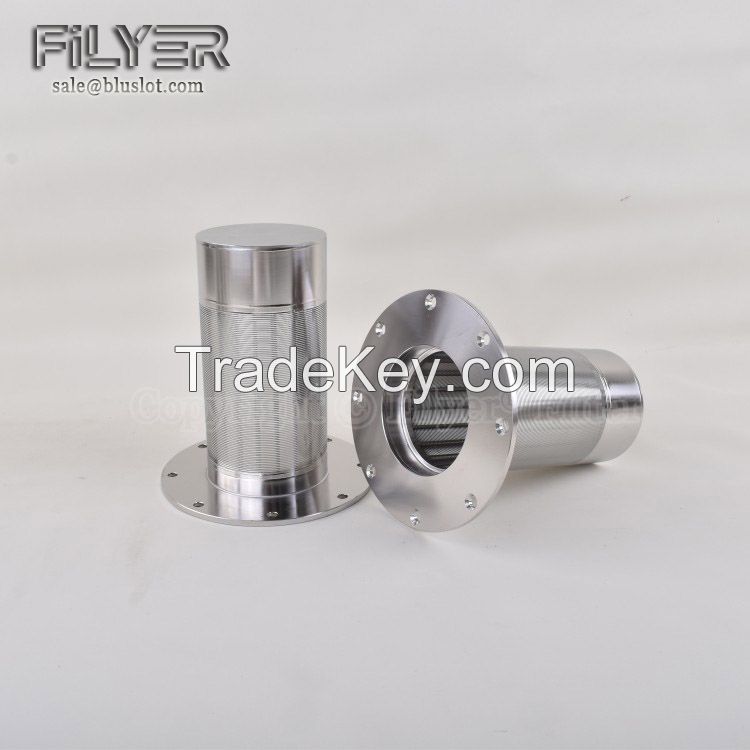




FOB Price
Get Latest Price|
- Minimum Order
Country:
China
Model No:
-
FOB Price:
Place of Origin:
-
Price for Minimum Order:
-
Minimum Order Quantity:
-
Packaging Detail:
-
Delivery Time:
-
Supplying Ability:
-
Payment Type:
-
Product Group :
Contact Person liu
Hengshui, Hebei
Resin trap
filter is generally installed at the back end of the negative bed,
positive bed, and mixed bed of the ion exchanger. When the quality
of the resin is poor and the water pressure disturbance is large
(especially high pressure
disturbance). When the resin is damaged, the resin will
enter the back-end desalted water system and affect the normal
operation of other equipment in the system, so a resin trap filter
screen needs to be installed.
On the water
system pipeline near the outlet of equipment containing resin such
as ion exchangers, install a resin trap filter screen with a hole
diameter much smaller than that of the resin. It also has a
flushing function. When the resin passes through, it can be
intercepted and captured by the filter screen. At the same time, it
is automatically flushed through the front and rear differential
pressure to discharge the captured resin out of the
system.
Resin trap
filter is used as a supplementary equipment of the ion exchanger to
prevent the trapped resin from leaking into the desalted water
system when the water outlet device
fails. To ensure the normal operation and use of
subsequent equipment. It has small size and high recycling
efficiency.
Our resin trap
filter uses stainless steel wedge wire screen as raw material. The
stainless steel trapezoid profile wire filter screen has high
capture efficiency, large flow area, good mechanical strength and
low pressure.
Resin trap filter selection can select the corresponding
specifications and models according to the flow rate in the above
table. Of course, we also provide customized services for materials
with special specifications. Resin trap filters are usually made of
high-quality stainless steel. Hydrochloric acid and sodium
hydroxide solutions are used in the regeneration process of the
front-end yin and yang mixed bed, which are highly
corrosive.
Low
quality. During the resin manufacturing process, due to improper
maintenance of process parameters, some or a large number of resin
particles will be cracked or broken, which is manifested in low
crushing strength of the resin particles and low balling rate after
grinding.
Frozen. Resin particles contain a large
amount of moisture inside. When stored or transported at sub-zero
temperatures, this moisture will freeze and expand in volume,
causing the resin particles to collapse. Frozen resin has a large
number of cracks visible under the microscope. Severe breakage will
occur within a short period of time after use. In order to prevent
the resin from freezing, the resin should be stored at ***0℃ and
avoid transportation during the freezing period.
Dry. Resin particles gradually lose their
internal moisture when exposed to air. The resin particles shrink
and become smaller. When dry resin is immersed in water, it quickly
absorbs water and the particle size expands. This causes cracking
and shattering of the resin. For this reason, the resin must be
kept sealed during storage and transportation to prevent drying
out. For dried resin, it should first be immersed in saturated salt
water. The high concentration of ions in the solution is used to
inhibit the expansion of resin particles. Then gradually dilute
with water to reduce cracking and breakage of the
resin.
Effect of osmotic pressure. During the
failure process of resin under normal operating conditions, the
resin particles will generate internal stress that expands or
contracts. During long-term use, resin repeatedly expands and
contracts, which is the main reason for cracks or breakage of resin
particles. The speed
of resin expansion and contraction depends on the speed of resin
transformation, which in turn depends on the salt concentration and
flow rate of the incoming water. When
gel-type resin is used for chemical desalination of natural water,
the maximum flow rate generally does not exceed *0m/h; when used
for condensate water desalination, the maximum flow rate generally
does not exceed *0m/h. Due to
its solid skeleton structure and large porosity, macroporous resin
can withstand large transformation speeds, and the flow rate of
condensate can be as high as **0m/h.
| Country: | China |
| Model No: | - |
| FOB Price: | Get Latest Price |
| Place of Origin: | - |
| Price for Minimum Order: | - |
| Minimum Order Quantity: | - |
| Packaging Detail: | - |
| Delivery Time: | - |
| Supplying Ability: | - |
| Payment Type: | - |
| Product Group : | Manure Separator |